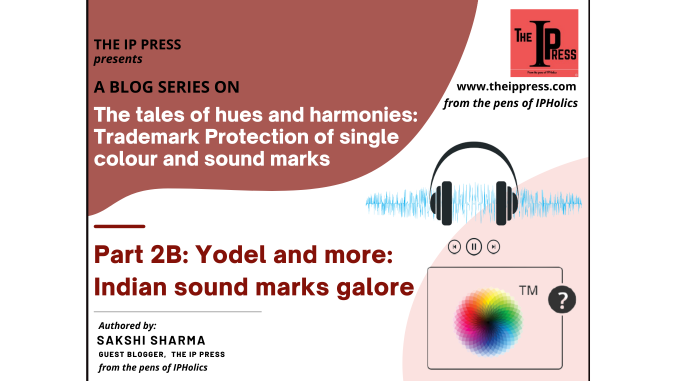
Part 2B: Yodel and more: Indian sound marks galore
Picking up where we left off last, the concept of sound trademarks is not new to India. The earliest sound mark registration dates back to 2008 for the Yahoo Yodel followed by Allianz Aktiengellschaft (Application No. 1421882). Some other sound marks registered include the Nokia tune (Application No. 1365394), Ting Ting Ti Ting (the 4 note bell sound) for Britannia Industries (Application No. 1913366) and even the theme song of the National Stock Exchange (Application No. 2152242). Akin to single colour marks, the Indian Trade Marks Act does not explicitly recognize sound marks and the interpretation usually flows from section 2(1)(m) that provides for the definition of‘ ‘marks’ and section 2 (1)(zb) that provides for the definition of ‘trademark’. In essence, if a device, brand, heading, label, ticket, name, signature, word, letter, numeral, shape of goods, combination of colours or any combination thereof (which is the definition of a mark), when “represented graphically” and having the “capability of distinguishing the goods/services of one person from another” would be entitled for trademark protection.
However, the Trade mark Rules, 2017 do explicitly mention sound marks under ‘Rule 26: Representation of Trademark’ wherein under sub-section (5), it is clearly mentioned that when an application is made for registration of a trademark that consists of a sound as a trademark, the same ought to be submitted in “graphical representation of notation of the sound” and in “MP3 format for 30 seconds or less” and the medium is such that it allows “easy and clearly audible replaying”. Beyond the rules, the Manual of Trademarks – Practice & Procedure that is adhered to by the Indian Trademark Registry specifies that ‘trademarks may consist of a sound and represented graphically by a series of musical notes with/without words’ and the standard for registrability of sound marks is the same as other trademarks, that of distinctiveness i.e. the average consumer can perceive the sound to goods/services of an entity. The Manual also specifies that when a sound is sought to be registered, the application must clearly state so or the mark would be registered as a word/device and additionally, the presumption is that sound marks do not qualify for acceptance, unless there is evidence of factual distinctiveness. What is interesting is that the Manual provides for examples of sounds that are incapable of registration such as – children nursery rhymes for goods/services of children, popular music for entertainment/park services, music associated with regions/countries for goods from that region/country, simple pieces of music using 1 or 2 notes and lastly – songs commonly used as chimes. This would imply that NBC Chimes, a mark registered in the US (US Serial Number 72349496) or the chimes for Intel mentioned previously would not be registrable in India.
The Last song: parting notes
Though there is no litigation as such where the validity of “sound marks” has been challenged, however, if the Ardagh metal case before the EU was consideration before an Indian court, it is likely that the verdict would remain the same owing to the lack of distinctiveness. The possibility of registration is further weakened by the fact that the sound of ‘Pop, silence and fizz’ is one inherent to the goods for which the registration is applied for and relying on the general presumption, it is necessary that factual distinctiveness is proved. It is indeed difficult to imagine a world where the sounds of ‘pop and fizz’ are monopolized and this would surely give all manufacturers of soft-drinks a tough challenge. Regardless of the jurisdiction, each sound mark must face the ‘music’ and satisfy the tenets of acquired distinctiveness and consumer recognition to ‘pop out’.
Link to the Part 1A of the article: https://www.theippress.com/2022/01/11/the-tales-of-hues-and-harmonies-trademark-protection-of-single-colour-and-sound-marks/
Link to the Part 1B of the article: https://www.theippress.com/?p=3346
Link to the Part 2A of the article: https://www.theippress.com/?p=3352

Sakshi Sharma
Author
Sakshi is a practicing Intellectual Property attorney who has worked as a litigation associate with a leading IP law firm. She has advised several national and international clients on contentious and non-contentious matters grounded in trademark, copyright, design and GI law and additionally, intersections of intellectual property law with advertising, consumer protection and information technology law. She is a graduate of Gujarat National Law University.
Leave a Reply